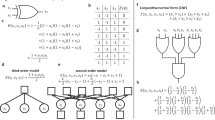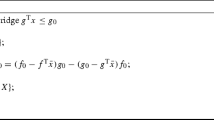Abstract
A new state space representation for a class of combinatorial optimization problems, related to minimal Hamiltonian cycles, enables efficient implementation of exhaustive search for the minimal cycle in optimization problems with a relatively small number of vertices and heuristic search for problems with large number of vertices. This paper surveys structures for representing Hamiltonian cycles, the use of these structures in heuristic optimization techniques, and efficient mapping of these structures along with respective operators to a newly proposed electrooptical vector by matrix multiplication (VMM) architecture. Record keeping mechanisms are used to improve solution quality and execution time of these heuristics using the VMM. Finally, the utility of a low-power VMM based implementation is evaluated.
Similar content being viewed by others
References
Larrinaga P, Kuijpers CMH, (1999) Murga: Genetic algorithms for the travelling salesman problem: a review of representations and operators. Artif Intell Rev 129–170
Tamir DE, Shaked NT, Wilson PJ, Dolev S (2009) High-speed and low-power electro-optical DSP coprocessor. J Opt Soc Am A 26:A11–A20
Karhi D, Tamir DE (2009) Caching in the TSP search space. In: Next generation applied intelligence, Tainan, Taiwan, pp 221–230
Wang L, Maciejewski AA, Siegel HJ, Roychowdhury VP (2005) A study of five parallel approaches to a genetic algorithm for the traveling salesman problem. Intell Autom Soft Comput 11(4):217–234
Shaked NT, Messika S, Dolev S, Rosen J (2007) Optical solution for bounded NP-complete problems. Appl Opt 46(5):711–724
Jog P, Suh JY, Van Gucht D (1989) The effects of population size, heuristic crossover and local improvement on a genetic algorithm for the traveling salesman problem. In: 3rd int’l conf genetic algorithms, pp 110–115
Goodman GW (1996) Introduction to Fourier optics. McGraw-Hill, New York
Feitelson DG (1988) Optical computing: a survey for computer scientists. MIT Press, Cambridge
Garey MR, Johnson DS (1979) Computers and intractability: a guide to the theory of NP-completeness. Freeman, New York
Johnson DS, McGeoch LA (1997) The traveling salesman problem: a case study in local optimization. Local Search in Combinatorial Optimization. Wiley, New York, pp 215–310
Applegate DL, Bixby RE, Vasek C, Cook WJ (2007) The traveling salesman problem: a computational study. Princeton University Press, Princeton
Gutfreund D, Shaltiel R, Ta-Shma A (2007) If NP languages are hard on the worst-case, then it is easy to find their hard instances. Comput Complex 16(4):412–441
Reinelt G (1991) TSPLIB—a traveling salesman problem library. ORSA J Comput 3(4):376–384; http://comopt.ifi.uni-heidelberg.de/software/TSPLIB95/
Haist T, Osten W (2007) An optical solution for the traveling salesman problem. Opt Express 15:10473–10482
Held M, Karp RM (1970) The traveling salesman problem and minimum spanning trees. Oper Res 18:1138–1162
Anonymous, Concorde TSP Solver, http://www.tsp.gatech.edu/concorde.html
Pearl J (1984) Heuristics: Intelligent search strategies for computer problem solving. Addison-Wesley, Reading
Russell SJ, Norvig P (1995) Artificial intelligence: a modern approach. Prentice-Hall, New York
Xi B, Liu Z, Raghavachari M, Xia C, Zhang L (2004) A smart hill-climbing algorithm for application server configuration. In: Proceedings of the 13th international conference on world wide web, pp 287–296
Vose MD (1999) The simple genetic algorithm: foundations and theory. MIT Press, Cambridge
Glover F, Laguna M (1997) Tabu search. Kluwer Academic, Norwell
Kennedy J, Eberhart RC (2001) Swarm intelligence. Academic Press, San Diego
Kirkpatrick S, Gelatt CD, Vecchi MP (1983) Optimization by simulated annealing. Science 220:671–680
Zilberstein S (1996) Using anytime algorithms in intelligent systems. AI Mag 17(3):73–83
Ramos T, Cozman G (2005) Anytime anyspace probabilistic inference. Int J Approx Reason 38(1):53–80
Aarts E, Lenstra J (2003) Local search in combinatorial optimization. Princeton University Press, Princeton
Ursache L (2007) Representation models for solving TSP with genetic algorithms. In: Proceedings of CNMI, Bacău, pp 291–298
Or I (1976) Traveling salesman types combinatorial problems and their relations to the logistics of regional blood banking. PhD thesis, Northwestern University
Borovska P (2006) Solving the travelling salesman problem in parallel by genetic algorithm on multicomputer cluster. In: Int conf on computer systems and technologies, pp 1–6
Gang P, Iimura I, Nakatsuru T, Nakayama S (2005) Efficiency of local genetic algorithm in parallel processing. In: Sixth international conference on parallel and distributed computing, applications and technologies, pp 620–623
Langdon WB, Banzhaf W (2008) A SIMD interpreter for genetic programming on GPU graphics cards. In: EuroGP, pp 73–85
Inoue T, Sano M, Takahashi Y (1997) Design of a processing element of a SIMD computer for genetic algorithms. In: Proceedings of the high-performance computing on the information superhighway, pp 688–691
Vega-Rodriguez MA, Gutierrez-Gil R, Avila-Roman JM, Sanchez-Perez JM, Gomez-Pulido JA (2005) Genetic algorithms using parallelism and FPGAs: the TSP as case study. In: International conference workshops on parallel processing, pp 573–579
Collings N, Sumi R, Weible KJ, Acklin B, Xue W (1993) The use of optical hardware to find good solutions of the travelling salesman problem (TSP). Proc SPIE 1806:637–641
Shaked NT, Tabib T, Simon G, Messika S, Dolev S, Rosen J (2007) Optical binary-matrix synthesis for solving bounded NP-complete combinatorial problems. Opt Eng 46(10):1–11
Oltean M (2008) Solving the Hamiltonian path problem with a light-based computer. Nat Comput 7(1):57–70
Oltean M, Muntean O (2008) Solving NP-complete problems with delayed signals: an overview of current research directions. In: Proceedings of 1st international workshop on optical supercomputing, pp 115–128
Pitsoulis L, Resende M (1995) Greedy randomized adaptive search procedures. J Glob Optim 6(2):109–133
Lowell D, El Lababedi B, Novoa C, Tamir DE (2009) The locality of reference of genetic algorithms and probabilistic reasoning. In: The international conference on artificial intelligence and pattern recognition, Florida, pp 221–228
Author information
Authors and Affiliations
Corresponding author
Rights and permissions
About this article
Cite this article
Tamir, D.E., Shaked, N.T., Geerts, W.J. et al. Parallel decomposition of combinatorial optimization problems using electro-optical vector by matrix multiplication architecture. J Supercomput 62, 633–655 (2012). https://doi.org/10.1007/s11227-010-0517-9
Published:
Issue Date:
DOI: https://doi.org/10.1007/s11227-010-0517-9




